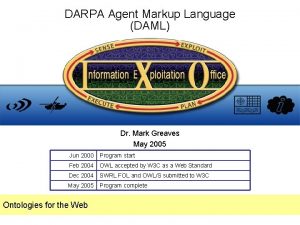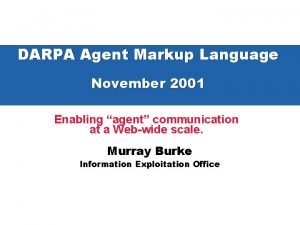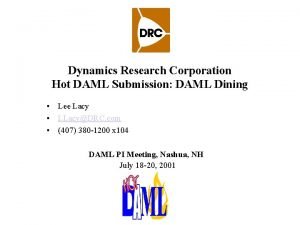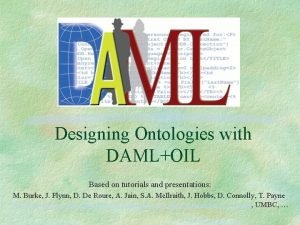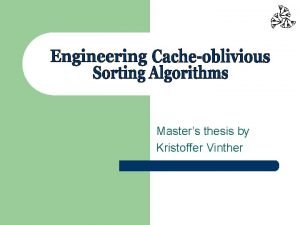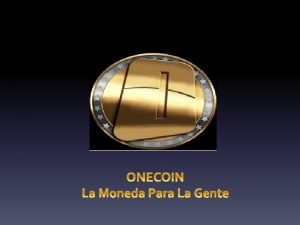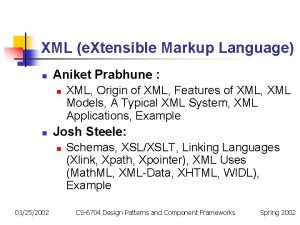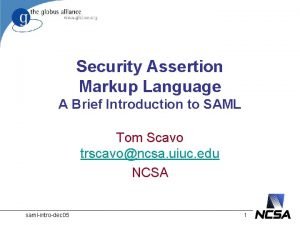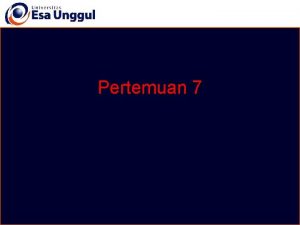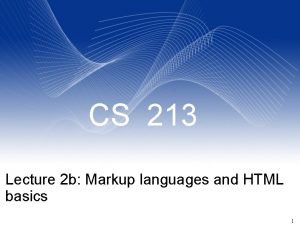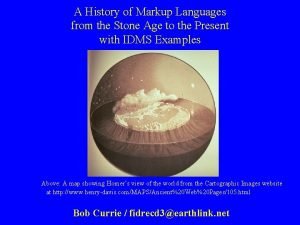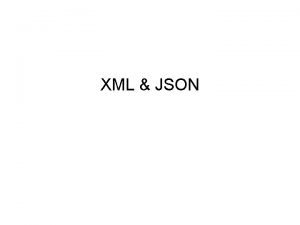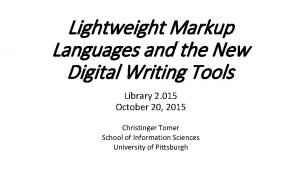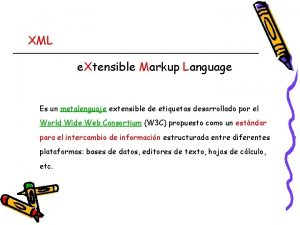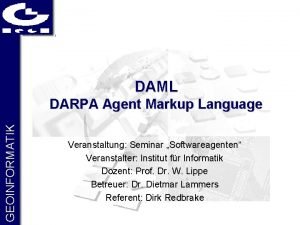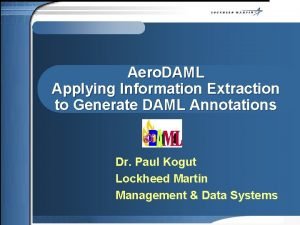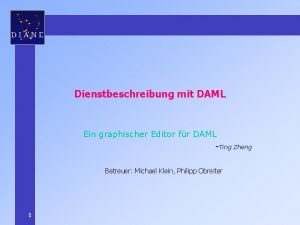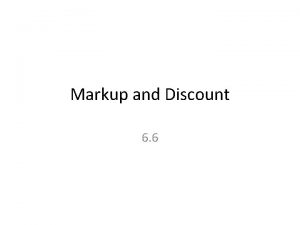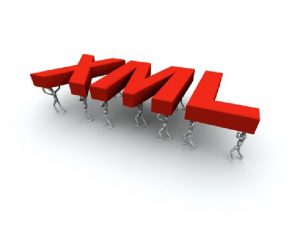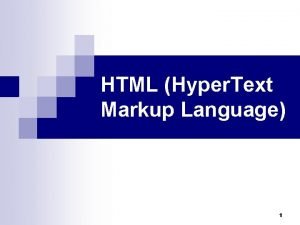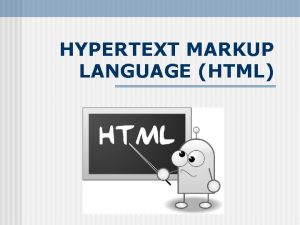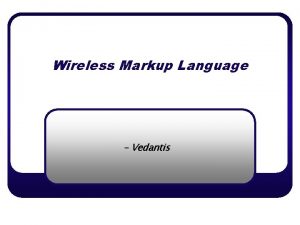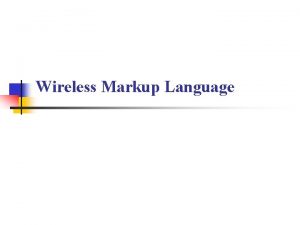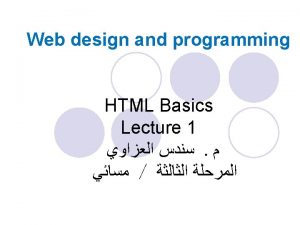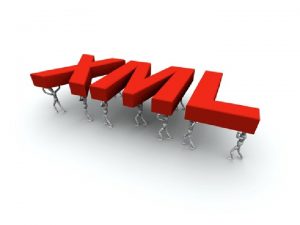DARPA Agent Markup Language DAML Dr Mark Greaves






![Transition Intelligence Community [6 funded pilots at different IC agencies] Do. D AF AMC Transition Intelligence Community [6 funded pilots at different IC agencies] Do. D AF AMC](https://slidetodoc.com/presentation_image_h2/78710b2dfc5a1898e51d8d3d7d3ea216/image-7.jpg)








- Slides: 15

DARPA Agent Markup Language (DAML) Dr. Mark Greaves May 2005 Jun 2000 Program start Feb 2004 OWL accepted by W 3 C as a Web Standard Dec 2004 SWRL FOL and OWL/S submitted to W 3 C May 2005 Program complete Ontologies for the Web 0

What is DARPA? DARPA = Defense Advanced Research Projects Agency Long Range R&D Organization of the US Department of Defense Established 1958 as a US response to the Soviet launch of Sputnik Pursues high-risk, high-payoff basic and applied research Organizationally part of USD(AT&L) and DDR&E Operates in coordination with, but independent of, the military research and development establishment (ARL, AFRL, ONR) Committed to maintaining U. S. military technology superiority Chartered to Prevent Technological Surprise Funds work that is a counterpoint to traditional thinking and approaches Noteworthy programs include VELA HOTEL, M-16, Stealth aircraft, GPS, ARPANET, Unmanned aircraft, most early AI, MEMS, ARPANET… FY 05 research budget is ~3 B DARPA Description and active solicitations at www. darpa. mil 1

DARPA, DAML, and Google… #2 #3 Google “darpa” on 10/21/04 2

DAML Program Summary Problem: Computers cannot process most of the information stored on web pages Solution: Augment the web to link machinereadable knowledge to web pages – Extend RDF with Description Logic – Use a frame-based language design – Create the first fully distributed web-scale knowledge base out of networks of hyperlinked facts and data Computers require explicit knowledge to reason with web pages b We P) c i T t an r HT m Se L ove (OW Approach: Design a family of new web languages – Basic knowledge representation (OWL) – Reasoning (SWRL, OWL/P, OWL/T) – Process representation (OWL/S) Links via URLs Build definition and markup tools Link new knowledge to existing web page elements Test design approach in the Intelligence Community Standardize the new web languages in the W 3 C 3 (H ) b We HTTP g n ver isti Ex ML o L/X TM People use implicit knowledge to reason with web pages

Program Elements • Web Ontology Language (OWL) – Enables knowledge representation and tractable inference across the web – Based on Description Logics and RDF • OWL Reasoning Languages – SWRL Rules Language: Supports business rules, policies, and linking between distinct OWL ontologies – OWL/P Proof Language: Allows software components to exchange chains of reasoning – OWL/T Trust Language: Represents confidence that OWL and SWRL inferences are valid – Based on Description Logic Programming • Semantic Web Services (OWL/S) – Allows discovery, matching, and execution of web services based on action descriptions – Unifies semantic data models (OWL) with process models (Agent) and shows how to dynamically compose web services – Based on process algebra and NIST PSL • OWL Tools 4 DAML Program Technical Flow Web Ontology Language (OWL) OWL/S: Semantic Web Services SWRL: Rules OWL/P: Proof OWL/T: Trust Completed standards process Started standards process Under development Each DAML Program Element includes specifications, software tools, coordination teams, and use cases

2004 Technical Progress • Web Ontology Language (OWL) – W 3 C accepted OWL; formed Semantic Web Best Practices Working Group to maintain the standard – W 3 C agreed to host Ontaria, a permanent public OWL ontology registry/download site – OWL gained traction (250 K RDF/OWL pages, 20 M+ triples, 10 K classes available on-line) – W 3 C Workshop on OWL in life science • OWL Reasoning Languages – SWRL 0. 6 released 24 May 2004 by the US/EU Joint Committee; being tested at JWAC, IMO, NSA – SWRL-FOL submitted to the W 3 C – Sweet. Rules complete – W 3 Rules Workshop April 27 -28 5 • Semantic Web Services – OWL/S Web Services Specification submitted to W 3 C – Semantic Web Services Interest Group chartered by W 3 C – Semantic Web Services Initiative (~45 organizations) coordinates commercial, DAML, and EU Framework 6 output – SWSL and SWSL-FOL submitted – W 3 C SWS Workshop June 9 -10 • OWL Tools – DAML sponsored a new open source website www. semwebcentral. org – Over 70 OWL tools released by DAML contractors – New OWL plugins for Eclipse – Currently 84 hosted projects, 3 M hits and >100 GB of downloads since Dec 2003
![Transition Intelligence Community 6 funded pilots at different IC agencies Do D AF AMC Transition Intelligence Community [6 funded pilots at different IC agencies] Do. D AF AMC](https://slidetodoc.com/presentation_image_h2/78710b2dfc5a1898e51d8d3d7d3ea216/image-7.jpg)
Transition Intelligence Community [6 funded pilots at different IC agencies] Do. D AF AMC Foreign Clearance Guide FCS SOSCOE OWL/S use in the TIN AF AMC NOTAMs Joint Explosive Ordinance Detection ACTD DISA Discovery Metadata Repository Center for Army Lessons Learned Prototype Federal CIO Council Semantic Interoperability Community of Practice formed, 2 conferences SWANS conference April 7 -8 2004 (300+ attendees, 40 trade show participants) Commercial 43 companies in SWSI working on OWL/S 19 commercial OWL implementations including IBM and HP More evidence of uptake… 58 “Semantic Web” books on Amazon. com NCI Thesaurus is 100% OWL NIH and NIST are sponsoring work to define a comprehensive protein chemistry taxonomy DARPA XG using OWL for policy language vocabulary 6

DAML Schedule Program Elements Web Ontology Language Rules Specification FY 02 FY 01 Work FY 03 Revisions (DAML+OIL), OWL Lite, OWL DL, OWL Full Logic Mappings, Descriptive Logic Programming, Tool Development Ontaria, OWL Versioning Create v 0. 6 Create v 0. 7 SWRL Reasoners Semantic Web Services Initiative Process Representation, Brokering, Profile, Grounding Ontologies Trust Specification OWL/S Editors Trust Algorithms Horus IC Transitions Saturn NOTAMS Meetings and Reviews FY 05 Proof Language and Query Engines Proof Specification Semantic Web Services FY 04 SWMU PI Meeting SWMU JWAC Combine Saturn II NGA JWAC ALV SWMU PI Meeting SWANS Mtg PI Meeting END FY 05 Remaining Tasks • • Complete OWL versioning tools, Ontaria, OWL/T 1. 0 Deliver OWL/S 1. 1 to W 3 C and complete OWL/S editors Complete SWRL 0. 6 reasoning environment and submit SWRL FOL Tools and Outreach – Semantic Web Applications for National Security (SWANS) and SWIG meetings – Stabilize and transfer semwebcentral. org and daml. org to W 3 C – Complete SWe. DE, IE plugin, and reference application 7 External Conf W 3 C Delivery Program Milestone

DAML’s Legacy Success = creating the conditions for early adopters to allow the semantic web revolution to succeed DAML has had incredible success We have gone from DARPA-hard challenge to accepted industrial standard in four years The PM has lost control of the technology It is time for OWL to leave the DARPA nest and fly There is more work to be done: OWL 2. 0, Semantic Web Services, Rules, Query Languages, Tools, Documentation, Killer Apps, Proof Exchange, Trust Domain-specific ontologies and applications More standards, collaboration with Europe, funding organizations More nonacademic conferences DAML’s intellectual thread will be carried by other programs and organizations So… What kind of new DARPA program would compliment DAML? 8

How Does a New DARPA Program Start? OLD NEW Program Offices Systems Offices Tech Offices 6. 4 Prototype 6. 1 DARPA Tech Idea “The Particle Accelerator” New Programs Must result in or point to a new military capability Must be about removing a technological barrier, not a policy barrier Problem must be “DARPA-hard”; typically 10 x improvement Barrier to capability must be primarily technical, not policy Must start from a specific new immature technology idea or ideas Specific = must be identified at the program approval phase New = typically based on work that is < 5 yrs old 9

The Heilmeyer Catechism What are you trying to do? Articulate your objectives using absolutely no jargon Example: “take anthrax off the table as a threat to our forces” What is the new military capability that your technology could provide? How is it done today, and what are the limits of current practice? Why is this specifically a technology problem? What's new in your approach and why do you think it will be successful? All software is Turing-equivalent, so software methodology is usually not relevant What is your argument/analysis that a 10 x difference in a technology will result in a new capability? Who cares? If you are successful, what difference will it make? Who is the customer for the new idea, and what evidence do you have that any transition will be successful? What are the risks and the payoffs? How much will it cost? How long will it take? What are the midterm and final exams to check for success? Metrics and experimentation plans must be defined up front 10

Other Program Questions What is DARPA’s Transition Strategy? How does new capability transfer to a Service or Agency? Gold: DARPA work leads to a direct acquisition Silver: DARPA work leads to a direct maturation effort by a Do. D PEO Bronze: DARPA work leads to a new capability that a contractor will try to sell back to Do. D Tin: DARPA work leads to a better state of the world Is there an MOU / MOA and funding in the POM? Why is this different from other DARPA and Do. D programs? What are our metrics for measuring our progress? Always difficult for software; exceptionally difficult for architectures What are the phases of the Program? Phase I is typically 12 -18 months Phase II funding is contingent on meeting specific agreed-upon phase I milestones 11

Program Creation Basics DARPA PM finds new technology idea(s) and links it to capability Seedling funding to explore idea and create program brief Typically $200 K - $300 K / 4 -6 months / 1 -3 contractors Solidify program argument, financials, milestones, phases, metrics, experimentation strategy, and program deliverable/transition/MOUs Seedling output is the newstart brief – not jumpstart technology Brief to DARPA Director Repeat a few times Solicitation construction and publication Source Selection (and possible plan revision) Multiple contractors, teams, areas of expertise Contracts Awarded via an Agent Program Phase I with milestones DARPA Director Brief for go/no-go Program Phase II with milestones 12

Sample Program: Dynamic User Interfaces MAIN OBJECTIVE Replace current mass-produced general-purpose UIs with task-sensitive, user-specific interfaces Customize each user’s I/O with the data sources User interacts with the web at the problem level User does not have to master all the data sources and algorithms that are available UI is automatically built for each user’s unique cognitive/perceptual talents, training, experience, and current problem context Allow UIs to better support independent hypothesis generation and unconventional concept exploration TECHNICAL APPROACH Use situation theory to quantify the information content of a UI Decompose user’s info tasks into UI task specifications Leverage OWL to create a tractable logic language that can express analytic tasks and data semantics Apply constraint-based solvers, CBRs, and other planning technologies to yield task-specific UI specs Map UI tasks onto available graphical elements EXPECTED IMPACT Faster and higher-quality analytic output Embrace individual styles and competencies Tune core UI planners to allow rapid confirmation or disconfirmation of different uncommon hypotheses Increase user satisfaction Increased agility in response to new missions Restructure planners and interfaces on the fly to handle new information requirements and data sources Build a semantically characterized set of UI graphical elements by using OWL/S and SWRL Interaction with the DBs structured around user task requirements, not data structures Use a planner/shape grammar and machine learning to derive the UI layout for an user’s individual profile Late binding the UIs relative to the individual user, task, and problem context allows for rapid learning and evolution of interface paradigms 13 Dynamically create the new UI on the user’s desk

How Is DARPA Different? Lightweight and nimble organizational model “ 120 PMs with a common travel agent” Currently organized into 8 tech offices plus the Director Technology – DSO, MTO, IPTO; Systems – ATO, TTO, IXO, SPO, J-UCAS Offices come and go fairly frequently and the tech/systems boundary is fluid No institutional incentives to collaborate No technical interdependencies No dedicated facilities beyond simple office space in Arlington, VA http: //www. darpa. mil has programs, solicitations, lists, areas of interest 4 -year personnel rotation policy embedded in the culture No institutional biases No empire building Always looking for new Program Managers with great technical ideas PMs come from academia, industry, government, military Must be a US citizen with the ability to hold a clearance Must be willing to work incredibly hard, travel extensively, and have a national-scale vision You will be changed by the experience, and you might change the world Come Join Us! 14
 Darpa agent markup language
Darpa agent markup language Darpa agent markup language
Darpa agent markup language Daml
Daml Daml tutorial
Daml tutorial Autohan
Autohan Kristoffer greaves
Kristoffer greaves Rosa greaves
Rosa greaves Dr kristoffer greaves
Dr kristoffer greaves Markup language examples
Markup language examples Security assertion markup language definition
Security assertion markup language definition Wml format
Wml format Markup language examples
Markup language examples History of markup language
History of markup language Json xml alternatives
Json xml alternatives Lightweight markup
Lightweight markup Tecnica de la encuesta
Tecnica de la encuesta
